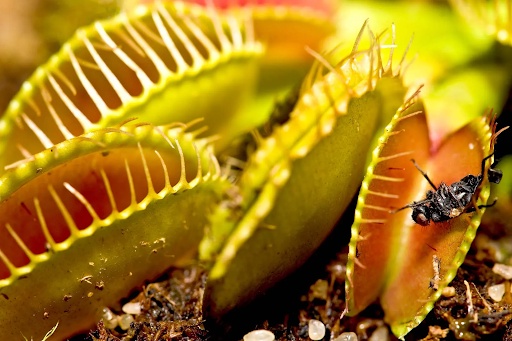Venus Fly Traps (Dionaea muscipula) is undeniably one of the most captivating and enigmatic plants in the world of botany. These carnivorous wonders have been a subject of fascination for generations, often shrouded in myths and misconceptions. In this blog, we'll separate fact from fiction as we delve into the intriguing world of Venus Fly Traps. By the end, you'll have a deeper understanding of these remarkable plants and how to care for them properly.
Venus Fly Traps Eat Human Fingers
Let's kick things off by addressing one of the most sensationalized myths about Venus Fly Traps - the idea that they can chomp down on human fingers. Countless horror movies have perpetuated this notion, but the reality is far less ominous. Venus Fly Traps are designed to capture and digest insects, primarily flies, not human appendages. Their traps are quite small and simply not equipped to consume anything as large as a human finger.
Venus Fly Traps Are Difficult to Grow
Some gardeners are deterred from cultivating Venus Fly Traps due to the belief that they are selective and demanding. While it's true that they have specific care requirements, they are not inherently difficult to grow. In their native habitat, these plants thrive in nutrient-poor, acidic soils. To mimic their natural environment, you can plant them in sphagnum moss and perlite, ensuring the soil is moist but not waterlogged. Place them in bright, indirect sunlight, and you're on the right track to success.
Venus Fly Traps Can Only Eat Live Insects
Another misconception is that Venus Fly Traps can only consume live insects. In reality, they can digest both live and dead prey. When an insect triggers the trap's sensitive hairs, the plant closes its leaves, creating an airtight chamber. Enzymes then break down the prey, extracting valuable nutrients. If the trap remains closed for an extended period without digestion, it will reopen to release the unpalatable meal.
Venus Fly Traps Need Constant Feeding
Contrary to popular belief, Venus Fly Traps do not require a constant supply of insects to thrive. In their natural habitat, they capture prey sporadically. While feeding them occasionally can boost growth, it's not essential for their survival. They can produce their energy through photosynthesis, using sunlight to convert carbon dioxide and water into glucose.
Venus Fly Traps Are Exclusively Indoor Plants
Many believe that Venus Fly Traps should only be grown as houseplants. While they can thrive indoors, they are also well-suited to outdoor cultivation, provided the suitable climate is suitable. These plants require a dormant period during the winter, where they experience lower temperatures to rest and prepare for the growing season. If you live in a region with mild winters, your Venus Fly Trap can be grown outdoors year-round.
Facts About Venus Fly Traps
Now that we've dispelled some common myths let's explore some intriguing facts about Venus Fly Traps:
- Native Habitat: Venus Fly Traps are native to the southeastern United States, primarily in North and South Carolina. They grow in boggy, nutrient-poor soils.
- Unique Trap Mechanism: The Venus Fly Trap's trapping mechanism is activated by tiny hairs on the inner surface of its leaves. When an insect touches these hairs, the trap closes within a fraction of a second.
- Conservation Concerns: Due to habitat destruction and poaching, Venus Fly Traps are considered a vulnerable species in the wild. Ensure you source your plants from reputable sources to support conservation efforts.
- Dormancy: Venus Fly Traps require a period of winter dormancy where they experience cooler temperatures and reduced light. This rest period is essential for their long-term health.
Conclusion
Venus Fly Traps are captivating plants that have intrigued and mystified people for generations. By separating fact from fiction and dispelling common myths, we can better appreciate these remarkable carnivorous wonders. Remember that while Venus Fly Traps have specific care requirements, they are not as challenging to grow as some believe. With the right care and understanding, you can cultivate these unique plants, be they succulent plants or other indoor ones, and enjoy their fascinating behaviours in your home or garden.


No comments yet